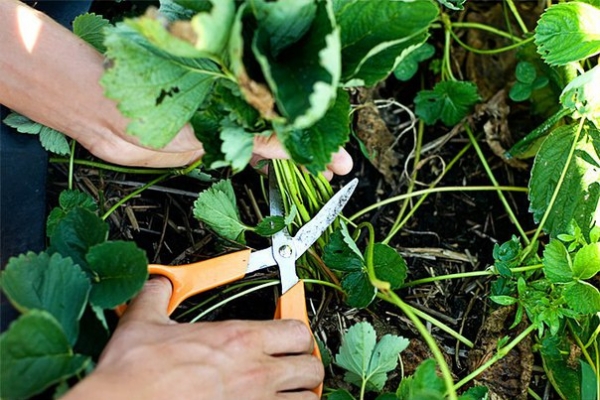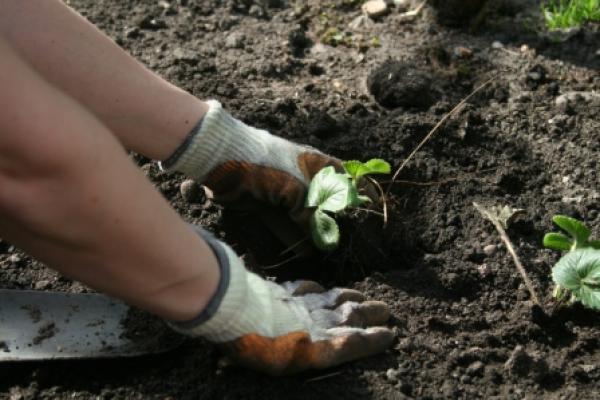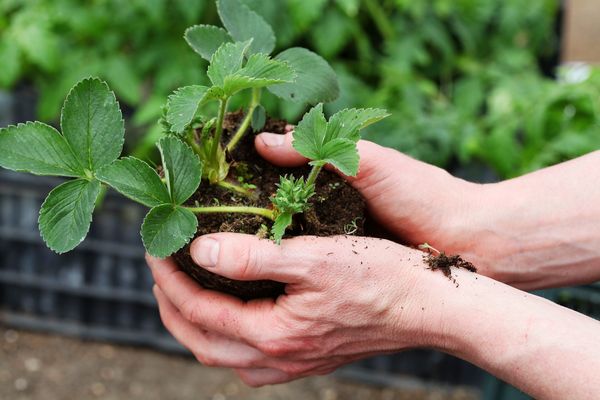Rules for processing strawberries in the fall
Content
Pruning
Start processing strawberries after harvesting by cutting off old leaves. It is very simple to distinguish them from new healthy leaves: the color of the old ones is darker, in addition, they have clearly visible lesions in the form of specks. The antennae with rosettes should also be trimmed. Except, of course, the very first rosette, which you can use as material for plant transplantation.
Not all gardeners agree on the need for pruning. Some argue that the leaves are the main vegetative organ of strawberries, and by cutting them off, we harm the bushes. But still, the fact remains, and no one can argue with the fact that old leaves are the favorite habitat of pests and diseases. Therefore, it is still worth agreeing that pruning after harvest is a necessary healing procedure.
In addition, do not forget that during the fruiting period, the plant managed to waste all the nutrients, so it needs rest. And pruning is a great way to give your strawberries a boost before next season.
You shouldn't wait for autumn to prune your plants. You can start getting rid of old leaves immediately after harvesting. And then, by September, the strawberries will have time to gain strength and acquire new green leaves. For pruning, you can use pruning shears, scissors, a sharp knife. Especially lazy people do not bother with this business, and simply mow the strawberry bushes. However, this often ignores the allowable cut height.
Remember that pruning too low can damage the growth bowl, which is needed for new foliage to develop. That is why you should not be lazy, but rather carefully cut the plants to a height of 10 centimeters from the ground.
Transfer
In the fall, after harvesting, you can start transplanting strawberries. There are still different points of view about when is it better to replant plants: in the spring (in April) or in the fall (in September)? Of course, every gardener has the right to decide for himself, but you must remember that by planting strawberries in September, you give them time and the opportunity to take root. The strawberries will bloom their leaves and also grow a good root system so they can survive the winter successfully. By the onset of cold weather, the plants will be strong and will be able to hide with their own leaves. Then neither frost nor lack of snow can harm them.
Of course, those plants that you plant in the fall will bloom and begin to bear fruit only in the spring. They will not be able to please you with the same large harvest as their 2-, 3-year-old relatives in the garden, but they will not leave you completely without delicious fragrant berries.
Before planting strawberries in the fall, make sure that there are no May beetles or wireworms in the soil, as they can cause enormous damage to the plants.
It is best to transplant in cloudy weather, or in the late afternoon. You can plant strawberries in 2 or 3 lines, it all depends on the width of the garden. Pour a lot of water into the holes before planting. The bushes should be placed in the grooves, and then gently spread the roots. After the water is absorbed, you can sprinkle the holes with earth. Tamp the soil a little with your hands so that it fits snugly around the base.After transplanting, the soil must be mulched.
Of course, you need to fertilize the soil before planting the plants. But still, before planting, you need to dip the plants in a nutrient mixture, which you can make from clay, water, manure.
Most gardeners strongly recommend processing the roots without fail, since top dressing will never be superfluous, but will only protect the bushes from dangerous diseases and pests.
Top dressing
Both old and newly planted bushes need organic fertilizers. It has been noticed that natural products such as humus or mullein are best suited for feeding berries. But at the same time, one should not forget that it is not worth using these organic fertilizers in their pure form, as this can provoke the appearance of leaf burns. If you want to do everything right, then it is better to dilute the mullein with water in a ratio of 1:10 and water the soil around the bushes. With humus, you can simply mulch the soil around the plants.
Some gardeners prefer to put chicken manure pellets under the bushes.
You can make a good top dressing with your own hands. Fill half of any sealed container with grass (tops, weeds are useful), add nitrogen fertilizer, and then fill it all with water. Let the mixture ferment for about ten days, and then use this "living water" to feed. However, it still needs to be pre-diluted with water in a 1: 1 ratio. Each bush needs to be watered with a liter of this fertilizer. The benefits of such feeding are even greater than from humus, because in addition to fertilizing plants, it provides another "bonus" - the neutralization of soil acidity.
After harvesting, strawberries need to be treated against one of the most common pests - the strawberry mite, which damages the leaves. It is very simple to calculate whether your plants are infected or not: if the bushes are sick, then the leaves are deformed and curled up. But even if healthy and lush foliage grows on the bushes, it will still not be superfluous to show prudence and, for prevention, treat the plants with a special solution that you can prepare at home. In a bucket of warm water (up to 30 degrees), you need to pour 2 tablespoons of soap (it is better to use liquid soap), 3 tablespoons of burnt vegetable oil, 2 tablespoons of wood ash and vinegar. Treat the leaves and soil around the bushes with this solution, and no pests and diseases can affect your future harvest.
To treat strawberries in the fall from a tick, you can use drugs such as Actellik, Kleschevit, Titovit Jet, colloidal sulfur solution. Slugs, snails, millipedes can also harm strawberries. To get rid of all this misfortune, you can simply spread metaldehyde granules under bushes in places where pests accumulate. 5 grams per square meter will be enough.
If you do not process the bushes from diseases and pests, then not only berries, but also neighboring plants may suffer. Therefore, do not forget about the timely and correct processing of strawberries with various preparations, because the well-being of the garden depends on this.
Do not forget to cover the strawberries for the winter so that they feel good even in severe frosts. You can use straw as a shelter, branches of spruce branches are also useful. Remember that frosty, snowless winters are very dangerous for plants, and a shelter will not only keep warm, but also trap snow.
Post-harvest strawberries are easy to care for. But there are still some rules that should not be ignored. After all, only armed with certain knowledge, you can do everything right. Then the plants will survive the winter perfectly and will bring a good harvest next season.
Video "Care of strawberries at different times of the year"
In this post, the expert talks about how to properly care for strawberries in spring, summer and autumn.

